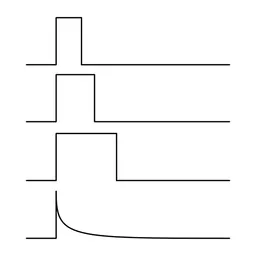In a recent patch, I had to utilize a technique that I thought was worth sharing. So today, we’ll take a quick look at trigger and gate conditioning and how they can help your patches.
The basic concept
Many trigger and gate sequencers offer either a fixed length, or a minimum length, for their pulse outputs that is longer than may be necessary for certain patches. In a lot of cases, this isn’t an issue, but sometimes, we’ll want a very short gate for a particular use. For example, I recently added a vactrol-based lowpass gate to my system, and it often sounds best with incredibly short trigger signals to avoid a sustaining phase.
Another spot that we can run into issues is when gate signals overlap with an audio path. Take a long gate signal – a second or more – and patch it to your mixer. You’ll hear two pops: one when the gate goes high, and one when the gate goes low. As we’ll see later, we need to have a trigger in the audio path to accomplish certain techniques, and this double-pulse behavior can cause unwanted artifacts.
To avoid this, we can either drastically reduce the length of the trigger so that the double pulse no longer sounds like two distinct pops, or we can change the shape of the trigger. Setting a trigger to a particular length can be useful, but is harder to do, and in most cases changing the trigger’s shape is good enough. So how do we do that?
Decay is inevitable
Using a decay-envelope generator, like the Pons Asinorum, is a great way to solve this problem. The extremely sharp attack still behaves as a trigger, but the smooth decay won’t cause double triggering, and is generally a non-issue in the audio path of a patch. DC offsets in audio can cause distortion in certain cases, but by using a short decay we can avoid this issue, too.

Applications
The most common place that I use this technique is when pinging filters. In this example, I’ve run a gate signal from a Doepfer gate sequencer into the audio input of a nearly-oscillating filter to create a nicely decaying pluck.
As you can hear, the long gate signal causes a second ping in a place that I don’t want. To solve this, I can run the gate through the Pons Asinorum with a quick decay before it hits the filter.
Problem solved! Filter pinging is a nice way to create organic decays, and has been used in things like drum machines to create boomy kicks. A few older analog drum modules that closely model this behavior can have issues with double-triggering when sent longer pulses, so this technique can be used to avoid extra hits, too.
The greatest hits: percussion
Speaking of percussion, the other spot that I often use this technique is in kick synthesis. If you’re a longtime reader of the blog, you’ll know I like using triggers in the audio path of kicks to create a sharp transient. By mixing a decaying sine wave and a trigger, it’s easy to create a boomy kick that sounds great for low-end emphasis.
As you can hear, we get an extra click in the middle of our drum due to the length of our trigger. Pons Asinorum to the rescue! As before, we can patch our drum trigger through Pons Asinorum before it hits the mixer to avoid the second click, and retain our big impact.






